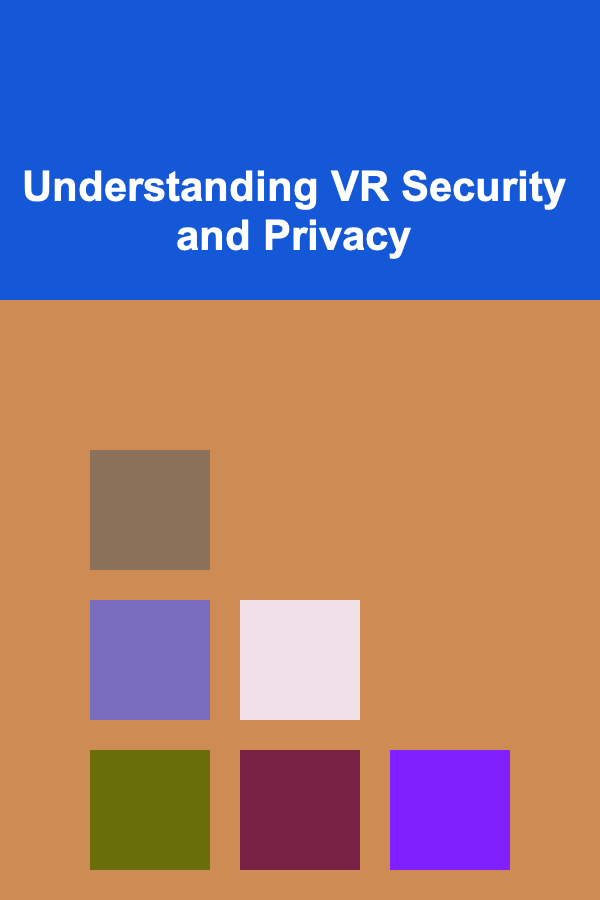
Understanding VR Security and Privacy
ebook include PDF & Audio bundle (Micro Guide)
$12.99$11.99
Limited Time Offer! Order within the next:

Virtual Reality (VR) is no longer a futuristic fantasy; it's a rapidly evolving technology transforming entertainment, education, healthcare, and numerous other sectors. As VR becomes more integrated into our lives, the security and privacy implications of this immersive technology demand careful consideration. This article provides an in-depth exploration of VR security and privacy challenges, discussing the unique vulnerabilities, potential threats, and best practices for mitigating risks.
The Unique Landscape of VR Security and Privacy
VR presents a unique set of security and privacy challenges that are not fully addressed by existing security paradigms. The immersive nature of VR, its reliance on sensor data, and its potential for collecting highly personal information create new avenues for exploitation.
1. Biometric Data and Identity Theft
VR headsets and controllers collect a wealth of biometric data about the user. This data includes:
- Head movements and eye tracking: These data points can reveal attentional focus, cognitive load, and even emotional state. They can also be used to uniquely identify individuals based on their specific movement patterns.
- Hand and body tracking: VR systems track hand and body movements for interaction within the virtual environment. These movements, like gait and gesture, are also biometric identifiers.
- Voice data: Many VR applications incorporate voice communication. Voiceprints, like fingerprints, are unique to individuals and can be used for identification.
The collection and storage of this sensitive biometric data raise significant privacy concerns. If compromised, this data could be used for identity theft, impersonation, or even for predicting and manipulating user behavior. Imagine a scenario where a malicious actor gains access to your VR headset data and uses it to create a realistic virtual avatar that mimics your movements and behavior. This avatar could then be used to spread misinformation, damage your reputation, or even commit financial fraud.
2. Data Collection and Profiling
VR platforms collect vast amounts of data about user behavior within the virtual environment. This data includes:
- Interaction patterns: How users interact with objects and other users in VR can reveal preferences, personality traits, and even hidden biases.
- Navigation data: Where users go and how they move within the virtual world provides insights into their interests and habits.
- Purchasing behavior: VR applications often include in-app purchases. Tracking these purchases allows companies to build detailed profiles of user spending habits.
This data can be used to create highly detailed user profiles that are then used for targeted advertising, personalized content recommendations, and even discriminatory pricing. Furthermore, the aggregation of VR data with other online and offline data sources can create an even more comprehensive and intrusive picture of an individual's life.
3. Social Engineering and Manipulation
The immersive nature of VR makes it a fertile ground for social engineering attacks. The sense of presence and realism in VR can make users more susceptible to manipulation and deception.
- Phishing attacks: Malicious actors can create convincing virtual environments that mimic legitimate websites or applications and trick users into entering their credentials.
- Impersonation: Attackers can create avatars that impersonate trusted individuals or authority figures, leading users to divulge sensitive information or perform actions they would not otherwise take.
- Emotional manipulation: VR experiences can be designed to evoke strong emotions, making users more vulnerable to manipulation and influence.
The ability to create realistic social interactions in VR makes it particularly challenging to distinguish between genuine interactions and malicious attempts at manipulation. This heightened vulnerability necessitates a greater awareness of social engineering tactics and a more critical approach to interactions within virtual environments.
4. Hardware and Software Vulnerabilities
Like any technology, VR headsets and applications are susceptible to hardware and software vulnerabilities that can be exploited by attackers.
- Firmware vulnerabilities: VR headset firmware can contain security flaws that allow attackers to gain control of the device or access sensitive data.
- Application vulnerabilities: VR applications can be vulnerable to common software vulnerabilities such as buffer overflows, SQL injection, and cross-site scripting.
- Hardware tampering: Attackers could physically tamper with VR headsets to install malware or extract sensitive data.
These vulnerabilities can be exploited to compromise user privacy, steal data, or even control the VR headset remotely. Regular security updates and careful selection of reputable VR applications are crucial for mitigating these risks.
5. Privacy of Bystanders
The use of VR in public spaces raises concerns about the privacy of bystanders. VR headsets often record video and audio of the surrounding environment. This data could inadvertently capture sensitive information about bystanders without their knowledge or consent.
For example, a VR user playing a game in a coffee shop might inadvertently record conversations or capture images of other patrons. This raises ethical and legal questions about the responsibility of VR users and developers to protect the privacy of those around them.
Potential Threats to VR Security and Privacy
The vulnerabilities described above create opportunities for various threats to VR security and privacy. These threats can range from simple data breaches to sophisticated attacks that manipulate user behavior.
1. Data Breaches
Data breaches are a common threat in the digital world, and VR is no exception. Attackers can target VR platforms and applications to steal user data, including biometric data, personal information, and usage patterns.
A successful data breach can have severe consequences for users, including identity theft, financial fraud, and reputational damage. Data breaches can also damage the reputation of VR companies and erode user trust.
2. Surveillance
VR technology can be used for surveillance purposes. Governments or corporations could use VR headsets and applications to monitor user behavior and gather intelligence.
This surveillance could be conducted without the user's knowledge or consent, raising concerns about privacy and freedom of expression. The potential for VR to be used as a tool for mass surveillance highlights the importance of strong legal protections for user privacy.
3. Manipulation and Propaganda
The immersive nature of VR makes it a powerful tool for manipulation and propaganda. Malicious actors can create realistic virtual environments that are designed to influence user beliefs and behaviors.
For example, a VR experience could be used to spread misinformation, promote extremist ideologies, or even manipulate voting behavior. The ability to create convincing simulations makes VR a particularly dangerous medium for spreading propaganda and manipulating public opinion.
4. Virtual Harassment and Abuse
VR can also be used for virtual harassment and abuse. Users can be subjected to offensive language, unwanted sexual advances, or even virtual physical violence within the virtual environment.
While virtual harassment may not have the same physical consequences as real-world harassment, it can still have a significant emotional and psychological impact on victims. The lack of physical boundaries in VR can make harassment particularly distressing and difficult to escape.
5. Physical Security Risks
VR can also pose physical security risks. Users who are immersed in VR may be unaware of their surroundings, making them vulnerable to accidents or even physical attacks.
For example, a VR user could trip and fall while navigating a virtual environment, or they could be targeted by a thief who knows they are distracted. It is important to be aware of the physical environment while using VR and to take precautions to prevent accidents and injuries.
Best Practices for Mitigating VR Security and Privacy Risks
Protecting your security and privacy in VR requires a multi-faceted approach that involves both individual users and VR developers and platforms.
1. User Best Practices
Individual users can take several steps to protect their security and privacy while using VR.
- Be aware of the data you are sharing: Pay attention to the data that VR applications are collecting and sharing. Read the privacy policies of VR platforms and applications carefully.
- Use strong passwords and two-factor authentication: Protect your VR accounts with strong passwords and enable two-factor authentication whenever possible.
- Be cautious of social engineering attacks: Be wary of requests for personal information or unusual actions within VR. Verify the identity of other users before sharing sensitive information.
- Use privacy settings: Adjust the privacy settings on your VR headset and applications to limit the amount of data that is collected and shared.
- Be aware of your surroundings: Be mindful of your physical surroundings while using VR to avoid accidents and injuries.
- Use a VPN: Consider using a VPN to encrypt your internet traffic and protect your IP address, especially when using VR in public Wi-Fi networks.
- Regularly update your VR software: Keep your VR headset firmware and applications up to date to patch security vulnerabilities.
- Install security software: Consider installing antivirus and anti-malware software on your VR device to protect against malicious threats.
2. Developer and Platform Best Practices
VR developers and platforms have a responsibility to protect the security and privacy of their users.
- Implement robust security measures: Use strong encryption, secure coding practices, and regular security audits to protect user data.
- Minimize data collection: Only collect the data that is necessary for the functionality of the VR application. Avoid collecting unnecessary or sensitive data.
- Be transparent about data practices: Clearly explain to users what data is being collected, how it is being used, and with whom it is being shared.
- Provide users with control over their data: Give users the ability to access, modify, and delete their data.
- Implement strong authentication and authorization: Use secure authentication methods to verify user identities and prevent unauthorized access to data.
- Provide clear and accessible reporting mechanisms: Enable users to easily report security vulnerabilities and privacy concerns.
- Design for privacy: Incorporate privacy considerations into the design of VR applications and platforms from the outset.
- Educate users about security and privacy risks: Provide users with clear and concise information about the security and privacy risks associated with VR.
- Comply with relevant privacy regulations: Adhere to all applicable privacy regulations, such as GDPR and CCPA.
- Implement content moderation policies: Establish clear policies and mechanisms for addressing harassment and abuse within VR environments.
3. The Role of Regulation and Policy
Government regulation and policy also play a crucial role in protecting VR security and privacy.
- Data privacy laws: Strong data privacy laws are needed to protect user data from being collected, used, and shared without their consent.
- Security standards: Establishment of security standards for VR hardware and software can help to ensure that VR devices are secure and protect user data.
- Consumer protection laws: Consumer protection laws can protect users from deceptive or unfair practices by VR companies.
- Regulations on the use of biometric data: Specific regulations are needed to address the unique privacy risks associated with the collection and use of biometric data in VR.
- Increased funding for research and development: Support for research and development in VR security and privacy can lead to innovative solutions that protect user data and promote a safer VR environment.
The Future of VR Security and Privacy
The future of VR security and privacy will depend on the collective efforts of users, developers, platforms, and regulators. As VR technology continues to evolve, it is crucial to stay ahead of the curve and develop new strategies for mitigating emerging security and privacy risks.
Some key trends that will shape the future of VR security and privacy include:
- Increased sophistication of attacks: Attackers will continue to develop more sophisticated techniques for exploiting VR vulnerabilities.
- Growing awareness of privacy risks: Users will become more aware of the privacy risks associated with VR and will demand greater control over their data.
- Advancements in privacy-enhancing technologies: New technologies, such as differential privacy and federated learning, will emerge to protect user data while still allowing for data analysis.
- Greater collaboration between stakeholders: Increased collaboration between users, developers, platforms, and regulators will be essential for addressing VR security and privacy challenges.
- Emphasis on ethical design: A growing emphasis on ethical design principles will help to ensure that VR technology is used responsibly and in a way that protects user privacy and promotes human well-being.
Conclusion
VR holds immense potential to transform various aspects of our lives. However, realizing this potential requires a proactive and comprehensive approach to security and privacy. By understanding the unique vulnerabilities of VR, the potential threats, and the best practices for mitigation, we can help to ensure that VR technology is used safely, securely, and responsibly. The responsibility rests on all stakeholders - users, developers, platforms, and regulators - to work together to build a future where VR enhances our lives without compromising our security and privacy.

How to Create a Checklist for Addressing Employee Burnout and Stress
Read More
How to Create a Signature Cocktail for Your Party
Read More
How to Incorporate Greenery for a Fresh Feel
Read More
The Public Relations Specialist's Playbook: Building Brand Reputation
Read More
How to Experience the Vibrant Nightlife of Berlin
Read More
How to Build a Strong Professional Presence Online
Read MoreOther Products

How to Create a Checklist for Addressing Employee Burnout and Stress
Read More
How to Create a Signature Cocktail for Your Party
Read More
How to Incorporate Greenery for a Fresh Feel
Read More
The Public Relations Specialist's Playbook: Building Brand Reputation
Read More
How to Experience the Vibrant Nightlife of Berlin
Read More